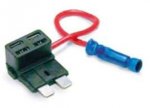LandCruiserPhil
Expedition Leader
If the vehicle is at idle and both batteries are low 12-12.6 would not be uncommon.
If the vehicle is at idle and both batteries are low 12-12.6 would not be uncommon.
ok my 70 amp alternator that only put out 35 amps at idle seems to be sending only 12-12.6 volts to either battery - shouldn't it be sending 13-14 to actually charge the batteries? what am I missing? this reminds me why I believe electrical work is a mystery to me
........
The fastest way to figure out where to run your wire to the fuse box is a 12V detector thingamajig. Turn your key to 'ON' (don't start truck) and then start probing empty holes in her fusebox. At some point your thingamajig will light up. Write down all her locations that lit up your thingamajig and turn her OFF. Then start probing those same empty holes in her fusebox that lit up your thingamajig again. Find any empty hole in her fusebox that lit up your thingamajig when she was turned ON but got no light from your thingamajig when she was turned OFF - that's the circuit you want to use (ALL THE TIME, if you get what I'm sayin)

Yea, that's sort of a difficult question, because every rig is different, so you have to sort of "wing it".
My truck has an "Add a Fuse" doohickey stuffed into a fuse slot that is ignition hot and feeds the solenoid:
http://www.wiringproducts.com/contents/en-us/d137_fuse_holders.html
View attachment 114324
As for the power draw of the solenoid - not much. Mine draws about an amp.
Um...#8 is bigger than #12.
But it should be no big deal, the solenoid doesn't draw much. What size fuse protects the wire you tapped off of?
Connect a 12GA wire from pin on the isolator to a fuse in your fuse box that is only 'hot' when the key is in the 'ON' position (aka the truck is running)
Yea, that is why I was wondering how much draw it has. Besides getting the "add a fuse" above, I took the directions as stuffing that wire into one side of the fuse connection and then putting the fuse back in. Is that seriously what some people are doing? I guess its not that off the wall.
From first post in this thread. That is what I am talking about.....
